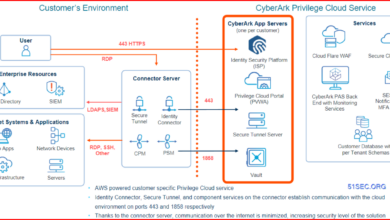Bitglass and the Rise of Cloud Security Posture Management
Bitglass and the rise of cloud security posture management (CSPM) – it’s a hot topic, and for good reason! As more businesses migrate to the cloud, the need for robust security solutions has exploded. This isn’t just about protecting data; it’s about maintaining compliance, preventing breaches, and ensuring business continuity. Bitglass, with its comprehensive CSPM offering, is playing a key role in this evolving landscape, offering organizations a powerful tool to navigate the complexities of cloud security.
Let’s dive into how it’s changing the game.
The cloud offers incredible flexibility and scalability, but it also introduces a whole new set of security challenges. Traditional security perimeters are dissolving, making it crucial to adopt a cloud-native approach to security. This is where CSPM solutions like Bitglass come in, providing continuous monitoring and automated remediation of security vulnerabilities across your cloud infrastructure. We’ll explore Bitglass’s specific features, compare it to competitors, and look at real-world examples of its impact.
Bitglass’s Role in Cloud Security Posture Management (CSPM)
Bitglass plays a significant role in the increasingly crucial field of Cloud Security Posture Management (CSPM). As organizations increasingly migrate to the cloud, the need for robust security solutions that can manage and monitor the security of cloud environments has become paramount. Bitglass offers a comprehensive platform that addresses many of the key challenges organizations face in securing their cloud assets.Bitglass’s Core Functionalities Relevant to CSPMBitglass provides a range of functionalities designed to improve an organization’s cloud security posture.
Its core CSPM capabilities include continuous cloud asset discovery and inventory, vulnerability management, configuration assessment, and compliance monitoring. The platform automatically discovers and classifies cloud assets, providing a comprehensive view of the organization’s cloud infrastructure. This visibility is crucial for identifying misconfigurations and vulnerabilities that could expose sensitive data. Bitglass then uses this information to assess the security posture of these assets against predefined security standards and compliance regulations, alerting administrators to potential risks.Bitglass’s Approach to Data Loss Prevention (DLP) in the CloudData Loss Prevention (DLP) is a critical component of any robust cloud security strategy.
Bitglass employs a multi-layered approach to DLP in the cloud. This includes data classification, access control, and data encryption. Bitglass’s CASB (Cloud Access Security Broker) capabilities allow for granular control over data access, preventing unauthorized users from accessing sensitive information. Furthermore, Bitglass utilizes advanced machine learning algorithms to identify and classify sensitive data, enabling proactive prevention of data breaches.
Data encryption both in transit and at rest adds another layer of protection, ensuring that even if data is compromised, it remains inaccessible to unauthorized individuals. For example, Bitglass can prevent sensitive documents from being downloaded to unapproved devices or shared via unauthorized channels.Comparison of Bitglass’s CSPM Capabilities with CompetitorsSeveral vendors offer CSPM solutions, and choosing the right one depends on specific organizational needs and priorities.
Below is a comparison of Bitglass with two competitors, McAfee MVISION Cloud and Netskope. Note that pricing can vary greatly depending on the specific features and number of users.
| Feature | Bitglass | McAfee MVISION Cloud | Netskope |
|---|---|---|---|
| Cloud Asset Discovery | Automated discovery and classification of assets across major cloud providers. | Automated discovery and inventory of cloud resources. | Automated discovery and classification of cloud assets, including shadow IT. |
| Vulnerability Management | Continuous vulnerability scanning and remediation recommendations. | Vulnerability assessment and remediation guidance. | Vulnerability detection and management with integration to other security tools. |
| Compliance Monitoring | Monitoring and reporting against various compliance standards (e.g., HIPAA, PCI DSS). | Compliance monitoring and reporting capabilities. | Compliance monitoring and reporting across various regulatory frameworks. |
| Data Loss Prevention (DLP) | Multi-layered DLP with data classification, access control, and encryption. | DLP capabilities with data discovery and classification. | Comprehensive DLP with advanced threat protection and data loss prevention. |
| Pricing Tiers | Subscription-based pricing with various tiers based on features and users. Specific pricing details are available upon request. | Subscription-based pricing with various tiers based on features and users. Specific pricing details are available upon request. | Subscription-based pricing with various tiers based on features and users. Specific pricing details are available upon request. |
| Customer Support | 24/7 support via phone, email, and online resources. | Multiple support channels, including phone, email, and online documentation. | Comprehensive support options including phone, email, and online resources. |
The Evolution of Cloud Security and the Rise of CSPM: Bitglass And The Rise Of Cloud Security Posture Management

The rapid adoption of cloud computing has fundamentally reshaped how businesses operate, offering unprecedented scalability, flexibility, and cost-effectiveness. However, this shift has also introduced a new set of security challenges. The distributed nature of cloud environments, coupled with the complexities of managing multiple cloud providers and services, has made securing these systems a significant hurdle for organizations of all sizes.
This challenge, in turn, fueled the demand for sophisticated security solutions, leading to the rise of Cloud Security Posture Management (CSPM).The increasing reliance on cloud services—from Software as a Service (SaaS) applications to Infrastructure as a Service (IaaS) and Platform as a Service (PaaS) offerings—exponentially expanded the attack surface for businesses. Traditional security perimeters became obsolete as data and applications migrated to the cloud, requiring a new approach to security that could adapt to the dynamic and distributed nature of cloud environments.
This necessitated a shift from perimeter-based security to a more holistic approach that focuses on continuous monitoring and assessment of cloud configurations and security posture. The limitations of traditional security tools in addressing these new challenges created a clear need for a dedicated solution: CSPM.
CSPM Technology Development Milestones
The development of CSPM technology wasn’t a sudden event but rather an evolution driven by the increasing complexity of cloud security. It built upon existing security technologies but adapted them to the unique characteristics of cloud environments. A timeline highlighting key milestones illustrates this progression:
While pinpointing exact dates for each stage is difficult due to the gradual evolution of the technology, we can broadly Artikel the key phases:
- Early 2010s: Initial focus on basic cloud security assessments, often manual and reactive. Security teams primarily relied on individual cloud provider security tools and lacked a centralized view of their cloud security posture.
- Mid-2010s: Emergence of early CSPM tools, primarily focusing on configuration management and compliance checks. These tools provided automated assessments but often lacked the depth and breadth of modern CSPM solutions.
- Late 2010s – Present: Significant advancements in CSPM technology, including the integration of advanced threat detection capabilities, vulnerability management, and automated remediation workflows. CSPM solutions evolved to provide a more comprehensive and proactive approach to cloud security, offering continuous monitoring and real-time alerts.
This evolution reflects a shift from reactive, manual security practices to a more proactive, automated approach. The increasing sophistication of cyber threats and the growing complexity of cloud environments have driven this rapid advancement in CSPM capabilities.
Challenges in Securing Cloud Environments
Securing cloud environments presents unique challenges compared to traditional on-premise infrastructure. These challenges include:
- Shared Responsibility Model: Cloud providers typically share responsibility for security with their customers. Understanding and managing this shared responsibility can be complex, leading to security gaps if not properly addressed.
- Complex Configurations: Cloud environments are often highly dynamic and complex, with numerous interconnected services and configurations. Managing and securing this complexity requires specialized tools and expertise.
- Data Sprawl: Data often resides across multiple cloud services and regions, making it difficult to track and protect. This data sprawl increases the risk of data breaches and compliance violations.
- Lack of Visibility: Traditional security tools often lack the visibility needed to effectively monitor and manage cloud environments. CSPM solutions address this by providing a centralized view of the entire cloud security posture.
- Rapidly Evolving Threats: The threat landscape is constantly evolving, with new attack vectors and vulnerabilities emerging regularly. CSPM solutions must adapt to these changes to remain effective.
Key Features of Bitglass’s CSPM Offering
Bitglass’s Cloud Security Posture Management (CSPM) solution stands out in the crowded market due to its unique approach to cloud security. Unlike many CSPM tools that focus solely on static assessments, Bitglass integrates its CSPM capabilities with its broader cloud access security broker (CASB) platform, providing a dynamic and comprehensive view of cloud security posture. This integrated approach allows for real-time visibility and control, enabling organizations to quickly identify and remediate risks before they can be exploited.Bitglass’s approach to cloud security posture assessment is built on continuous monitoring and automated analysis.
It leverages advanced machine learning algorithms to identify anomalies and potential threats, going beyond simple compliance checks to detect subtle indicators of compromise. This proactive approach ensures that organizations are always aware of their current security posture, allowing them to adapt and respond to evolving threats effectively. The solution provides a single pane of glass view across all cloud environments, regardless of provider, offering a holistic perspective that is crucial for effective security management.
Bitglass’s CSPM Assessment Capabilities, Bitglass and the rise of cloud security posture management
Bitglass’s CSPM offering doesn’t just identify vulnerabilities; it provides context and prioritization, enabling organizations to focus their remediation efforts on the most critical risks. The assessment engine analyzes configuration settings, access controls, data exposure risks, and compliance posture across various cloud services, providing a comprehensive risk profile. This detailed analysis goes beyond simple pass/fail results, providing detailed explanations and recommendations for remediation.
This ensures that security teams are not only aware of the problem but also understand how to address it effectively.
Remediation Capabilities and Actions
Bitglass assists organizations in remediating identified security vulnerabilities through several key mechanisms. The platform provides actionable insights and automated remediation capabilities where possible. This means that instead of simply reporting a problem, Bitglass helps fix it.
- Automated Remediation: Bitglass can automatically fix certain misconfigurations, such as insecure storage settings or improperly configured access controls, reducing the manual effort required by security teams. For example, if Bitglass detects an S3 bucket with public access enabled, it can automatically remediate the issue by restricting access.
- Policy Enforcement: Bitglass allows organizations to define and enforce granular security policies across their cloud environments. This ensures that cloud resources are configured according to best practices and organizational security requirements. For instance, organizations can enforce policies that require multi-factor authentication for all cloud access, or that restrict access to sensitive data based on user roles.
- Integration with Existing Security Tools: Bitglass integrates with existing security information and event management (SIEM) and other security tools, providing a centralized view of security events and enabling automated responses. This reduces alert fatigue and improves the overall efficiency of security operations.
- Detailed Reporting and Dashboards: Bitglass provides comprehensive reporting and dashboards that track the organization’s security posture over time, allowing for continuous monitoring and improvement. These reports provide valuable insights into the effectiveness of security controls and help identify areas that need further attention. For example, a dashboard could show the trend of misconfigurations over time, highlighting improvements or areas needing additional focus.
Bitglass’s Integration with Other Security Tools
Bitglass’s strength lies not only in its robust CSPM capabilities but also in its seamless integration with a wide array of existing security tools. This interoperability is crucial for building a comprehensive and effective security posture, avoiding redundant efforts and maximizing the value of each security investment. By acting as a central hub, Bitglass enhances the overall security architecture, providing a unified view and streamlined management of cloud security risks.Bitglass integrates with various security information and event management (SIEM) systems, cloud access security brokers (CASBs), and endpoint detection and response (EDR) solutions.
This integration allows for the aggregation of security data from multiple sources, providing a holistic view of the organization’s security landscape. This unified view enables faster threat detection and response, reduces alert fatigue, and streamlines incident management. The integration facilitates automated workflows, enabling actions such as automated remediation of identified vulnerabilities based on policies set within Bitglass and triggered by alerts from other security tools.
Bitglass and the rise of Cloud Security Posture Management (CSPM) are crucial in today’s cloud-first world. Securing these environments requires a multifaceted approach, and that includes understanding how application development impacts security. This is where the innovations discussed in this article on domino app dev the low code and pro code future become relevant; secure app development practices directly influence the overall CSPM posture.
Ultimately, effective CSPM with Bitglass needs to integrate seamlessly with modern development methodologies for optimal protection.
Bitglass Integration with SIEM Systems
The integration with SIEM systems, such as Splunk or QRadar, is a key component of Bitglass’s overall security strategy. Bitglass feeds crucial security logs and events into the SIEM, enriching the context of security alerts and providing valuable insights into potential threats. This allows security analysts to correlate events from different security tools, enabling more accurate threat detection and faster incident response.
For example, a suspicious login attempt detected by Bitglass can be automatically correlated with other suspicious activities detected by the SIEM, leading to a quicker and more informed response. This integration significantly improves the accuracy and efficiency of threat hunting and incident response activities.
Bitglass’s Enhancement of Existing Security Measures
Bitglass doesn’t replace existing security measures; instead, it complements and enhances them. For example, while a traditional firewall protects the network perimeter, Bitglass extends this protection to the cloud, securing data and applications regardless of location. Similarly, Bitglass works in conjunction with existing CASBs to provide more granular control over cloud access, offering advanced features like data loss prevention (DLP) and threat prevention capabilities.
By providing a centralized platform for managing cloud security, Bitglass streamlines operations and reduces the complexity of managing multiple security tools.
Hypothetical Security Architecture with Bitglass
A robust security architecture should incorporate multiple layers of defense, with Bitglass acting as a central orchestrator of cloud security.
The architecture would include a traditional network perimeter security (firewall, intrusion detection/prevention systems), endpoint security (EDR solutions, antivirus software), a SIEM system for log aggregation and analysis, and a CASB solution like Bitglass for cloud security posture management and data protection.
The integration would look something like this: Bitglass receives data from the endpoint security tools, identifying potential threats. This information is then forwarded to the SIEM, which correlates it with other security events. If a threat is identified, Bitglass can automatically take action, such as blocking access to sensitive data or revoking user privileges. The entire process is automated and streamlined, allowing security teams to focus on higher-level tasks and strategic initiatives.
The SIEM, in turn, can provide contextual information to Bitglass, enhancing its threat detection capabilities. This collaborative approach ensures a holistic and proactive security posture, mitigating risks across the entire organization’s IT infrastructure.
Case Studies
Bitglass’s impact on cloud security is best understood through real-world examples. While specific client data is confidential, we can illustrate the transformative power of Bitglass’s CSPM solution with a hypothetical case study based on common challenges faced by organizations.
Hypothetical Case Study: Improving Security Posture at a Financial Institution
This case study focuses on “First National Bank,” a mid-sized financial institution facing increasing challenges in securing its cloud environment. Before implementing Bitglass, the bank relied on a patchwork of disparate security tools, leading to significant vulnerabilities and inefficiencies.
Before Bitglass Implementation
First National Bank’s cloud security posture was fragmented and reactive. Their existing security tools lacked comprehensive visibility across their multi-cloud environment (AWS and Azure), resulting in significant blind spots. They experienced several security incidents, including a data breach involving sensitive customer information due to misconfigured cloud storage. This breach resulted in a $500,000 fine from regulatory bodies and a significant loss of customer trust.
Their incident response time was slow, often taking days to identify and contain breaches, leading to further data exposure and financial losses. Their security team spent a significant portion of their time on manual tasks, leaving them with limited time for proactive security measures. Their overall security posture score, measured using a standard industry benchmark, was a low 60 out of 100.
After Bitglass Implementation
Following the implementation of Bitglass’s CSPM solution, First National Bank experienced a significant improvement in their cloud security posture. Bitglass provided a unified view of their cloud environment, allowing them to identify and remediate vulnerabilities quickly. The automated policy enforcement features significantly reduced the risk of misconfigurations and data breaches. Their incident response time decreased dramatically; breaches were now identified and contained within hours.
The improved visibility and automation freed up the security team to focus on more strategic initiatives. The reduction in security incidents and improved compliance reduced their regulatory fines and operational costs. Their overall security posture score increased to 92 out of 100.
Quantifiable Improvements
- Reduced security incidents: A 75% reduction in the number of security incidents reported after implementing Bitglass.
- Improved incident response time: A 90% reduction in incident response time, from an average of 48 hours to less than 5 hours.
- Increased security posture score: An increase from 60 to 92 on a standard industry benchmark.
- Cost savings: A reduction in regulatory fines and operational costs estimated at $300,000 annually.
Improved Security Posture Illustration
Imagine a visual representation of a network. Before Bitglass, the network is depicted as a chaotic jumble of wires and servers, with some segments highlighted in red to indicate vulnerabilities and breaches. A small, overwhelmed security team is depicted trying to manage this complex system. After Bitglass implementation, the network is depicted as clean, organized, and well-protected. The red segments are gone, replaced by a clear, consistent blue, signifying the secure state of the network.
The security team is shown confidently monitoring the system with the help of Bitglass’s dashboard, which provides clear and concise information about the network’s security status. A large green shield, representing Bitglass, is prominently displayed, protecting the entire network. The overall image conveys a sense of security, control, and efficiency.
Future Trends in Cloud Security and Bitglass’s Position

The cloud security landscape is constantly evolving, driven by the increasing adoption of cloud services, the rise of sophisticated cyberattacks, and the emergence of new technologies. Understanding these trends is crucial for CSPM vendors like Bitglass to maintain their relevance and effectiveness. This section explores some key future trends and how Bitglass is strategically positioned to address them.The increasing complexity of cloud environments, coupled with the expanding attack surface, necessitates a more proactive and intelligent approach to security.
This shift requires CSPM solutions to be more adaptive, automated, and integrated with other security tools to provide comprehensive protection.
Serverless Computing Security
Serverless computing architectures, while offering significant scalability and cost benefits, present unique security challenges. Traditional security models struggle to adequately protect these ephemeral environments. Bitglass’s future development will focus on extending its CSPM capabilities to encompass serverless functions, providing visibility and control over serverless deployments. This will involve integrating with serverless platforms and providing security policies specifically tailored to this architecture, addressing issues such as function-level access control and data protection within serverless functions.
For example, Bitglass could integrate directly with AWS Lambda or Google Cloud Functions, providing real-time monitoring and automated remediation of security vulnerabilities.
AI and Machine Learning in CSPM
Artificial intelligence (AI) and machine learning (ML) are transforming various aspects of cybersecurity, including CSPM. These technologies enable more accurate threat detection, automated incident response, and predictive security analytics. Bitglass is already leveraging AI and ML in its platform for tasks such as anomaly detection and threat prioritization. Future development will see a greater emphasis on using these technologies to improve the accuracy and efficiency of its CSPM capabilities, leading to more proactive threat mitigation and reduced operational overhead.
This could involve developing AI-powered tools for automatically identifying and remediating misconfigurations, predicting potential security breaches, and adapting security policies based on real-time threat intelligence.
Zero Trust Security Model Adoption
The zero-trust security model, which assumes no implicit trust within or outside an organization’s network, is gaining widespread adoption. CSPM solutions play a vital role in implementing a zero-trust approach in the cloud by providing granular access control, continuous monitoring, and automated policy enforcement. Bitglass’s existing capabilities align well with the zero-trust model, and future development will further enhance its ability to support this paradigm.
This will include improvements to its data loss prevention (DLP) capabilities, enhanced user and entity behavior analytics (UEBA), and tighter integration with identity and access management (IAM) systems. A real-world example would be Bitglass automatically enforcing least privilege access to cloud resources based on real-time risk assessments and user context.
Extended Detection and Response (XDR) Integration
XDR solutions provide a unified view of security events across multiple environments, including cloud, endpoints, and networks. Integrating CSPM with XDR enhances threat detection and response capabilities by correlating cloud security posture data with other security signals. Bitglass is strategically positioned to leverage XDR integration to provide a more comprehensive and effective security posture. Future development will focus on strengthening its integrations with leading XDR platforms, enabling seamless data sharing and automated incident response workflows.
This would involve developing APIs and connectors to facilitate data exchange and automating remediation actions based on XDR alerts, improving the overall efficiency and effectiveness of incident response.
Closing Notes
In short, Bitglass is more than just a CSPM solution; it’s a strategic partner in securing your cloud journey. By offering comprehensive visibility, automated remediation, and seamless integration with existing security tools, Bitglass empowers organizations to confidently embrace the cloud while mitigating risks. As the cloud security landscape continues to evolve, Bitglass is well-positioned to remain a leader, helping businesses navigate the challenges and capitalize on the opportunities of this transformative technology.
Stay tuned for more insights into the ever-changing world of cloud security!
Top FAQs
What is the difference between CASB and CSPM?
CASB (Cloud Access Security Broker) focuses on controlling user access to cloud applications and data, while CSPM focuses on securing the cloud infrastructure itself. Bitglass offers both capabilities.
How does Bitglass pricing work?
Bitglass typically uses a subscription-based pricing model, often tiered based on features and the number of users or devices. Contact Bitglass sales for detailed pricing information.
Does Bitglass support multi-cloud environments?
Yes, Bitglass is designed to support multi-cloud environments, providing a unified view and control across various cloud providers.
What types of integrations does Bitglass offer?
Bitglass integrates with a wide range of security tools, including SIEMs, SOAR platforms, and other security information and event management systems. Specific integrations vary; check their documentation for the latest list.





